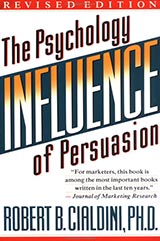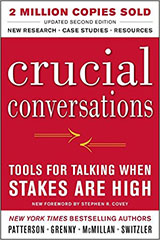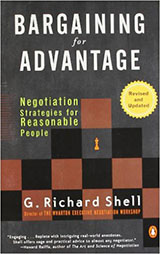My Notes on “Influence – The Psychology of Persuasion” by Robert Cialdini: Continue reading “Influence – The Psychology of Persuasion by Robert Cialdini”
Continue reading “Influence – The Psychology of Persuasion by Robert Cialdini”
What Got You Here Won’t Get You There by Marshall Goldsmith
My Notes on “What Got You Here Won’t Get You There” by Marshall Goldsmith: Continue reading “What Got You Here Won’t Get You There by Marshall Goldsmith”
Crucial Conversations, Tools For Talking When The Stakes Are High by Kerry Patterson
My Notes:
- Focus on what you really want.
- What do I want for myself?
- For others?
- For the relationship?
- How would I behave if this were what I really wanted?
- Contrast to fix misunderstanding:
- Start with what you don’t intend or mean, then explain what you do intend or mean.
- Don’t be tempted to water down your content: “you know it’s really not that big a deal”
- What story am I telling myself?
- Victim story: It’s not my fault!
- Villain story: It’s all your fault!
- Helpless story: There’s nothing else I can do!
- Re-examine the cold hard facts, question my conclusions look for other possible explanations. What do I really want? What would I do right now if I really want these results?
- STATE your path
- Share your facts
- Tell your story (explain what you’re beginning to conclude)
- Ask for others’ paths (encourage them to share their facts and stories)
- Talk tentatively (state your story as a story – don’t disguise it as fact)
- Encourage testing (make it safe for others to express differing or opposing views)
- To get people to share
- Ask (express an interest)
- Mirror (acknowledge their emotions)
- Paraphrase (restate what you’ve heard to show you understand, and that its safe for them to share)
Bargaining for Advantage by G. Richard Shell
So How Do You Ensure You Have The Advantage When Negotiating? My Notes:
- Prepare thoroughly in advance
- Locate the decision maker
- Built rapport
- Discover the other party’s goals – ask questions, obtain information on interests, issues and perceptions. Test for understanding, summarise, probe first then disclose, signal regarding your leverage
- If you open then you benefit from setting the anchor point.
- Look for common ground
- On what issues might the other side say “no”?
- Search for low-cost options that solve the other party’s problems while advancing your goals
- Trade issues
- Leverage
- Flows to those with the greatest control and comfort with the present situations.
- Threats must be credible.
- For whom is time a factor?
- Create momentum by giving little things.
- Create a vision that the other side has something to lose from no deal
- Positive leverage: Is having something the other guy wants, or better, needs, or best, cannot do without
- Negative Leverage: Threat based, with hints rather than shouts
- Normative Leverage: Give and take
- Leverage changes constantly through the negotiation
- Leverage depends on the other party’s perceptions of the situation, not the facts
- Closing Technique: Scarcity Effect
- Competition (many others are interested)
- Deadlines (we will withdraw the offer soon)
- Walkouts (I will get up and leave at any time)
- Closing Technique: Overcommitment
- eg standing in line at DisneyLand
- Leverage loss aversion (“We’ve come so far, don’t let all this time and effort go to waste!”)
- Softer Closing Technique: Split the difference
- Beware Rogue Tactics:
- Lies about bottom lines and alternatives
- Low-balling
- Phoney issues / decoy / red herring
- Fake authority ploys
- Overcommitment (drags out the negotiation process and raises or lowers the price or terms at the last minute)
- Good guy / bad guy
- Consistency traps (The goal of which is to pre-commit you to a seemingly innocent standard. They get you to agree to a statement before telling you why the statement is important)
- Reciprocity ploys (“I made a concession, now its your turn”. Beware of reciprocity traps – “Here’s a flower, may I have a donation?”)
- The nibble (just before closing hoping your exhausted)
